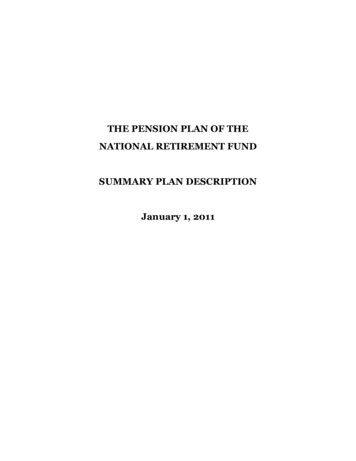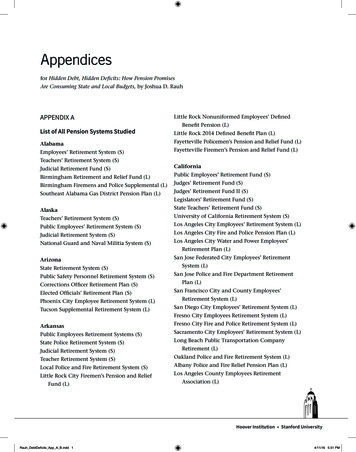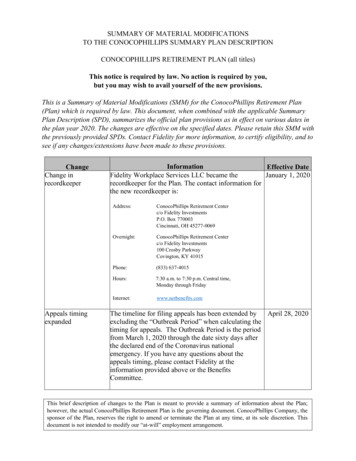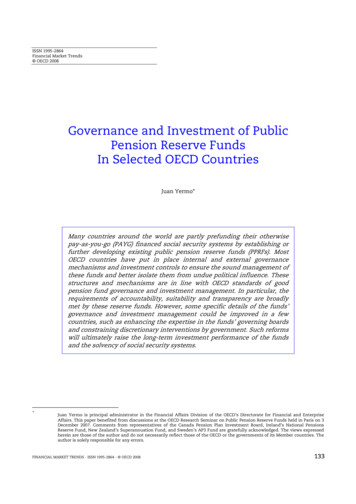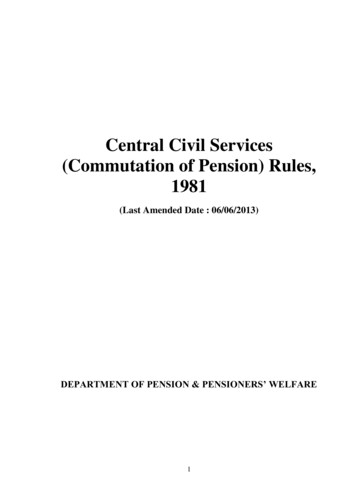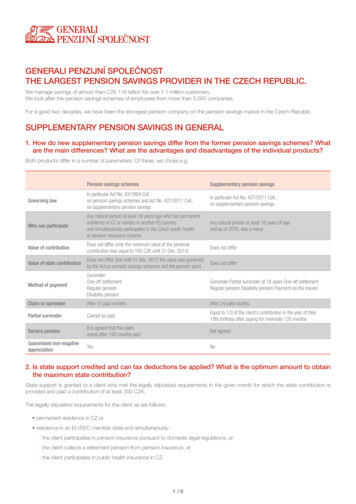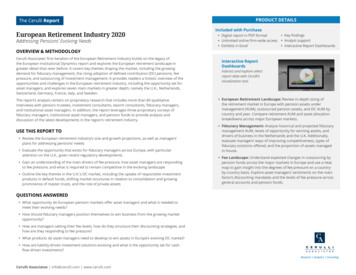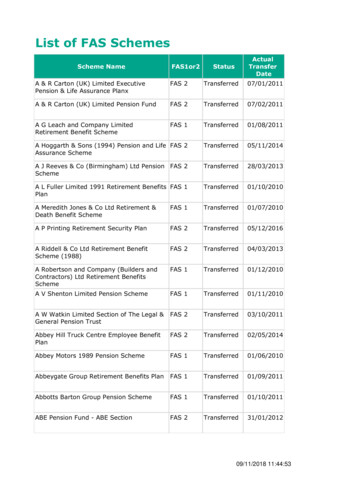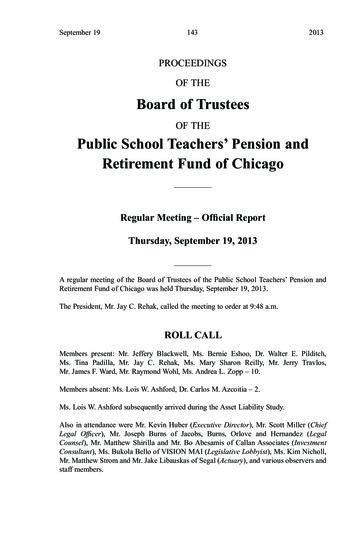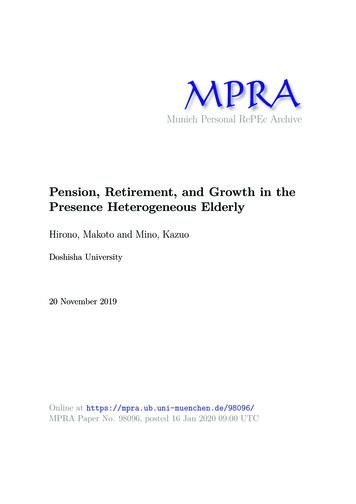
Transcription
Munich Personal RePEc ArchivePension, Retirement, and Growth in thePresence Heterogeneous ElderlyHirono, Makoto and Mino, KazuoDoshisha University20 November 2019Online at https://mpra.ub.uni-muenchen.de/98096/MPRA Paper No. 98096, posted 16 Jan 2020 09:00 UTC
Pension, Retirement, and Growth in the PresenceHeterogeneous ElderlyMakoto Hironoyand Kazuo MinozNovember 24, 2019AbstractThis study explores the linkage between the labor force participation of the elderlyand the long-run performance of the economy in the context of a two-period-lived overlapping generations model. We assume that the old agents are heterogeneous in theirlabor e ciency and they continue working if their income exceeds the pension that canbe received in the case of full retirement. We rst inspect the key factors that determine the labor supply of old agents. We then examine analytically as well as numerically the long-run impact of labor participation of the elderly on capital accumulation.Keywords: retirement decision, labor force participation, population aging, pensionsystem, capital accumulationJEL classi cation: E10, E62We thank Hiroki Arato, Koichi Futagami, Taakeo Hori, Tatsuro Iwaisako, Kazutoshi Miyazawa, AkiraMomota, Naoto Jinji, Shinichi Nishiyama, Ryoji Ohodoi, Ryosuke Shimizu, Koichi Yotsuya, and seminarparticipants at Osaka University, Kyoto University, and Tokyo Institute of Techonogy for their helpful comments on earlier versions of this paper. Mino’s research is nancially supported by JSPS KAKENHI projectNo.16KT0089 and No 17H02524.yGraduate School of Economics, Doshisha University, Karasuma Higashi-iru, Imadegawa, Kamigyo-ku,Kyoto, 602-8580 Japan, E-mail: cxwb1101@mail3.doshisha.ac.jpzCorresponding Author, Department of Economics Doshisha University and Institute of Economics, KyotoUniversity, E-mail: kmino@mail.doshisha.ac.jp
1IntroductionIn many developed countries, the labor force participation of the elderly substantially declinedduring the mid-1960s and the late 1980s. It was pointed out that the enhancement of socialsecurity programs in those countries promoted earlier retirement, which was the main sourceof the decrease in the labor force participation of the elderly. However, since the early 1990s,the rates of the labor force participation of the elderly in several industrialized countries havebeen increasing. For example, according to the Aging Society White Paper 2017 issued bythe Japanese Cabinet O ce, the labor force’s share of the Japanese elderly aged 65 yearsand over increased from 5.9% in 1980 to 11.8% in 2016. Currently, more than 50% of theJapanese elderly aged 65–69 years engage in full-time- or part-time jobs. Such a trend stemsfrom rises in longevity and health status of the elderly as well as from changes in the socialenvironment that increase the activeness of the elderly. Additionally, researchers claim thata change in the elderly’s labor supply is closely related to pension reforms. As mentionedbelow, several empirical studies, which use data of various countries, con rm that the recentrise in the labor force participation of the elderly had a statistically signi cant link to pensionreforms implemented in those sampled industrialized countries after the 1990s.In this study, we examine a model that may capture the basic facts mentioned above.First, we elucidate the key factors that determine the labor force participation of the elderly.Subsequently, we explore the long-run impacts of a rise in the labor force participation ofthe elderly on the aggregate economy. For this purpose, we construct a two-period-livedoverlapping generations model in which the labor force participation of the old agents isendogenously determined. Based on this analytical framework, we investigate how changes invarious factors that determine the labor force participation of the elderly a ect the behaviorsof key macroeconomic variables in the long run.Speci cally, in our model economy, the young agents are assumed to be homogeneous andthey fully devote their available time to working. However, the old agents are heterogeneousin the sense that their labor e ciency di ers from each other. We assume that the old agentsdraw their labor e ciency from a given distribution function at the beginning of their oldage. We also assume that there is a compulsory pay-as-you-go pension plan nanced bytaxation on the young generation’s income. Given this setting, each old agent compares the2
expected pension revenue in the case of full retirement with the income that can be earnedfrom the labor force participation; this determines the agent’s decision to either fully retire orparticipate in the labor force . Such a decision determines a cuto level of labor e ciency—the agents who have a lower e ciency level than the cuto select full retirement, and theagents whose e ciency exceeds the cuto continue working in their old age. We show thatthe pension scheme set by the government as well as the rate of population aging directlya ect the threshold level of labor e ciency, thereby determining the labor force participationof the elderly.The production side of the economy follows the standard neoclassical growth model.Therefore, in the long-run equilibrium capital and income grow at an exogenously speci edpopulation growth rate, and per capita levels of capital and income stay constant over time.Given this setting, we analytically show that an increase in the labor force participation ofthe old agents, generally, increases the steady state level of capital stock per population of theyoung generation. In addition to the theoretical discussion, we examine numerical examplesto evaluate quantitative impacts of changes in the degree of population aging and the policyparameters on the labor force participation of the elderly and the steady state level of capital.Our numerical discussion reveals that magnitudes of those impacts are sensitive to the shapeof the distribution function of the labor e ciency of the old agents.Related Litreture(i) EmpiricsA number of authors conduct empirical studies on the relationship between social securityand labor force participation of the elderly based on the data in various counties1 . Concerningthe decline in the labor force participation of the elderly during the period 1960–1990, Gruberand Wise (1999, 2004, and 2007) provide meticulous research outcomes. Among others,Gruber and Wise (1999) present detailed empirical studies on 11 industrialized countries andreveal that an increase in the generosity of the social security plan contributed towards theinternational trend of the decline in the labor force participation of old persons2 . In contrast,the recent studies focus on the persistent rise in the labor force participation of the elderly12A well-cited earlier empirical study on this topic is Krueger and Pischke (1992).Gruber and Wise (1998) summarize their main ndings.3
since the early 1990s. For example, Oshio et al. (2011) examine the impact of social securityreforms on the labor force participation of the Japanese elderly over a period of 40 years(1968-2007). They nd that the labor force participation of the elderly started increasingafter the 1985 reform that reduced the generosity of social security bene ts, including pensionplans3 . In a similar vein, Berkel et al. (2004) study the impact of pension reforms on theretirement decision of the German elderly population, while Bottazzi et al. (2008) and Bovini(2018) discuss the e ect of pension reforms on the elderly’s retirement decision and wealthaccumulation in Italy. Additionally, Coil (2015) presents a useful survey on empirical studieson this topic4 .Several authors point out that health condition is also important for the labor force participation of the elderly. Kalwji and Vermeulen (2008) investigate the impact of health conditionon the labor force participation of the elderly in 11 European countries. They provide careful estimation results and clarify the multidimensional nature of the health condition of theelderly. Overall, their results reveal that health status is one of the major factors that a ectsthe retirement decision of the elderly. Similar studies are conducted by Mete and Schlutz(2002) on Taiwan and by Cai (2007) on Australia5 .(ii) TheoryMany authors modify Diamond’s (1965) overlapping generations (OLG) model to introduce endogenous labor supply of the old agents. The most popular idea in the eld is toassume that young agents fully devote their available time to working, whereas old agentsmake the labor-leisure choice. In this setting, an increase in the labor force participation ofthe elderly means that old agents select a lower level of leisure time. A sample of this typeof formulation includes Zhang and Zhang (2009), Gon and Liu (2012), Mizuno and Yakita(2013), and Hirazawa and Yakita (2017). Since this modelling assumes that agents are homogeneous, all the old agents select the same level of partial retirement that corresponds to thelength of leisure time they choose. A de ciency of this formulation is that it fails to capturethe fact that, in reality, a substantial number of the elderly fully retire.On the other hand, a few authors have examined models in which the full retirement deci3Higuchi et al. (2006), Shimizutani (2013), and Shimizutani and Oshio (2013) present further evidence.See also Coil and Levine (2018).5Gacía-Pèrez et al. (2013) present an empirical study on the relationship between retirement incentive,pension, and employment status based on the Spanish data.44
sion of the elderly is endogenously determined. Among others, Matsuyama (2008) constructsa two-period-lived OLG model in which old agents make a discrete choice between workingand retirement by comparing utilities obtained in alternative situations. In his model, agentsin each cohort are homogeneous; this ensures that the decision regarding the choice betweenworking and retirement is uniform among the elderly6 . Aisa et al. (2015) introduce agentheterogeneity. In their model, each agent is endowed with a given labor e ciency, at theoutset of the agent’s life, and agents whose labor e ciency exceeds an endogenously determined threshold level work in their old age. Although the basic idea of Aisa et al. (2015) issimilar to our model, the authors treat a two-period model, and hence the long-run e ect ofthe old agents’ labor supply on capital accumulation is not updated in their study7 . Whencompared to the foregoing formulations mentioned above, our model, which emphasizes theheterogeneity of old agents, has an advantage— it can simultaneously determine full retirement of some old agents as well as the aggregate level of labor force participation of theelderly in a dynamic environment.Concerning the link between the social security and labor force participation of the elderly,Diamond and Mirrlees (1978) present an early theoretical study. These authors explore optimal social insurance in the presence of endogenous retirement and asymmetric information.In macroeconomics research, Hu (1979) conducts one of the earliest studies on the impactof social security on labor supply of the elderly in the context of Diamond’s (1965) OLGmodel. In his model, the old agents make the labor-leisure choice and they receive a pensionfor their leisure time. Given this setting, Hu (1979) explores the long-run e ect of a pay-asyou-go pension system on capital accumulation. Recently, Hu’s modelling was employed byMiyazaki (2017), who examines the optimal social insurance in the presence of endogenousretirement. Cipriani (2018) also uses a similar setting to study the macroeconomic impact ofpopulation aging8 . Since the analytical frameworks used by Hu (1979), Miyazaki (2017), andCipriani (2018) are essentially the same as the models of Zhang and Zhang (2009) and others6Matsuyama (2008) shows that the model involves multiple steady states so that a poverty trap arises.Gon and Liu (2012) indicate that if the model allows partial retirement, then it would imply that the steadystate equilibrium is uniquely determined. Since the model discussed by Gon and Liu (2012) is a variant of thelabor-leisure choice models mentioned above, it does not depict full retirement of some of the old agents.7It must be pointed out that Matsuyama (2008) brie‡y examines a modi ed model in which disutility levelsof labor is heterogeneous among agents; this ensures that some old agents fully retire in equilibrium. However,he does not consider this line of formulation in detail.8See also Phillippe and Pestieau (2013).5
mentioned above, their discussions do not depict the full retirement decision of the elderly.Again, it is worth emphasizing that our model with heterogenous elderly can highlight therelationship between pension schemes and the full retirement of the elderly in a coherentmanner9 .The rest of the paper is organized as follows. Section 2 constructs the analytical frameworkfor our discussion. Section 3 inspects the existence and stability of the steady state equilibrium of the model economy. Section 4 characterizes the relationship between the steady stateequilibrium and the key parameters involved in the model. Section 5 concludes.2Model2.1HouseholdsConsider an overlapping generation economy in which each agent lives for two periods, youngand old. We assume that young agents live for one period with certainty, but they facea probability of surviving to the old age. We denote the probability of surviving as2(0; 1]: Each cohort consists of a continuum of agents, and the mass of cohort grows at aconstant rate of n: We denote the population of cohort born at the beginning of the period tas Nt : Then, it holds that Nt 1 (1 n) Nt : Since the population share of the old generationin period t is Nt (Nt 1 Nt ) (1 n) ; population aging means that a decline inthe population growth rate, n and/or a rise in the probability of surviving, :When young agents are homogeneous and each agent inelastically supplies one unit oflabor. When old agents become heterogeneous in the sense that their labor e ciencies di ersfrom each other. Such a di erence in labor e ciency stems from di erences in each agent’shealth status and the motivation for labor force participation, among others. We assume thatthe labor e ciency, denoted by h; is in between( 0) and 1: Namely, there is a minimumlevel of e ciency of old person’s labor, ; and the most able old agents have the same levelof labor e ciency as that of young agents. We also assume that the cumulative distribution9Here, we focus on theoretical studies based on the two-period lived OLG models. There are severalquantitative studies on the relationship between social security programs and labor supply in the context ofcalibrated multi-period lived OLG models: see, for example Kitao (2014 and 2015).6
function of h is speci ed as a truncated Pareto distribution in such a way that1h11F (h) ; 1; 0 1h 2 [ ; 1] :(1)The functional form F (h) is set for analytical convenience. Additionally, in our model,the income of an old agent who works increases with the agent’s labor e ciency, h: Sinceforegoing empirical studies reveal that an upper tail of income distribution of the elderlyfollows a Pareto distribution, our speci cation may be an empirically plausible one10 .In our model, if the agents born in period t survive in period t 1, then they draw theirlabor e ciency, h; from F (h) at the beginning of period t 1: It is assumed that h isindependent and identically distributed (i.i.d) over time as well as across agents. In addition,the probability distribution of h is assumed to be stationary. Therefore, the share of oldagents with a particular level of labor e ciency is constant and the same in each cohort.The objective function of an agent born at the beginning of period t is a discounted sumof expected utilities of consumption in both periods:Ut Et log [ct log xt 1 ]0 1; h 2 [ ; 1] ;where ct and xt 1 ,respectively, denote an agent’s consumption in the agent’s young and oldages, andis a given discount factor. When the agent in cohort t is young, the agent’s ‡owbudget constraint isc st wtwhere st is saving, wt is the real wage, andtt;represents an amount of income tax. In oldage, the agent’s budget constraint is given byxt 1 (1 rt 1 ) st mt 1 ;where rt 1 is the real interest rate in period t 1; and mt 1 denotes the agent’s expected10Concerning the recent study on income distribution among the Japanese elderly, see Shirahase (2015) andSeiyama (2016).7
income in old age11 . Combining the budget constraints given above, we obtain the intertemporal budget constraint:ct xt 1 wt1 rt 1t mt 1:1 rt 1(2)Maximizing Ut subject to (2) ; we nd that the optimal levels of consumption and saving are,respectively, given byct 11 xt 1 st wttwtt(1 rt 1 )1 wtct 1 (wt mt 11 rt 1t t)mt 11 rt 1(1 (3);;mt 1:) (1 rt 1 )(4)(5)The expected income in old age, mt 1 ; is determined in the following manner. As mentioned earlier, in the beginning of t 1; an agent born in period t draws own labor e ciencyfrom the given distribution of h: We assume that an old agent with ability h can o er h 100%a young worker’s labor service. Given the speci cation of the distribution of labor e ciency,if an old agent born in period t retires, then the agent would receive a pension, pt 1 : However,if an old agent continues to work, then the agent would receive a part of the pension for thefully retired old, (1) pt 1 (0 1), as a basic pension. Since we have assumed thatthe old agent with labor e ciency h is h100% that of an young worker, the competitivewage o ered for an old agent with h is hwt 1 : The old agents hope to obtain the maximumamount of income in their old age, and hence the ex-post income in the old age is given bymax fpt 1 ; hwt 1 (1)pt 1 g ;0 1:As a result, the cuto level of labor e ciency of the old agents isht 1 pt 1:wt 1(6)11In this paper, we assume that the wealth of unsurvived agents is consumed by the government. Alternatively, we may assume that there is a competitive annuity market with free entry. In this case, the budget(1 rt 1 )constraint of an old agent becomes xt 1 st mt 1 : Our analytical outcomes are essentially thesame under such an alternative setting.8
An old agent who draws h ht fully retires, while an agent with hht continues workingin old age12 . Since the old agent retires with the probability F ht 1 or continues workingF ht 1 ; under the rational expectations hypotheism the income inwith the probability 1the old age expected in period t will bemt 1 F ht 1 pt 1 1whereR1ht 1(1F ht 1) pt 1 Z1hwt 1 dF (h) ;(7)ht 1hwt 1 dF (h) is the expected wage income for an old agent who stays in the laborforce. In the above. the rst three terms in the right hand side expresses the expected pensionincome, and the last term represents the expected wage income.2.213 .FirmsThe production side of our model is the standard one. The nal good and factor markets arecompetitive. There is a representative rm that produces a homogeneous good according tothe following production technology:Yt AKt Lt1;0 1;(8)12We assume that if h h ; then the old agents would continue to select work.Alternatively, we may assume that each agent draws h in the beginning of his life. In this case, the optimalconsumption of young agents who draw h h is13cRh;t 11 wtt pt 11 rt 1forh) pt 1 hwt 11 rt 1forThe optimal consumption of each young agent with hcWh;t 11 wtt (1h :h ish1:Hence, the average consumption of young agents is given byZ 1Z hcWcRh;t dF (h)h;t dF (h) h1 1 wtt F (h ) pt 1 [1F (ht 1 )] (1) pt 1 Z1hwt 1 dF (h)ht 1which is the same as derived above. Although the results are the same, we consider that our formulationpresents a more realistic situation than the model in which the destiny of each agent is determined at theoutset of her life. .9
where Yt is the output, Kt is the aggregate capital stock, and Lt is the input of labor service.The rm employs both young- and old-workers’ labor service, Lyt ; and Lot ; respectively sothatLt Lyt Lot :(9)We assume that one unit of hours of work of a young agent yields one unit of labor service,meaning that Lyt also denotes the total hours of work of the young agents. Similarly, it isassumed that one unit of hours of work of an old agent whose labor e ciency is h gives hamount of labor service. Thus, if we denote the hours of work of type h old agents by lh;t ;then the aggregate input of old workers’ labor service will beLotZ 1hlh;t dF (h):(10)htThe pro t of the rm ist AKtLyt Z!11hlh;t dF (h)htwt Lytrt K tZ1(wt h)lh;t dF (h) :htThe rm maximizes pro t by selecting Kt ; Lyt and lh;t ; and the rst-order conditions for anoptimum are given byAKt(1h (11 1Ltrt 0;) AKt Lt) AKt Ltwt 0;hwt 0 for h 2 [ht ; 1] :(11)(12)(13)Since conditions (12) and (13) are symmetric, the total demand of labor service isLt [(12.31) A] wt1Kt :(14)GovernmentWe assume that there is a pay-as-you-go pension plan in which the tax for social securityis levied on the young agents’ wage income14 . The tax revenue of the government ist 14In reality, income tax also applies to the old agents’ wage income. In our model, we ignore any governmentspending, except for pension payments, we assume that old agents’ wage income is free from taxation.10
wt ; where2 (0; 1) is the ‡at rate of the wage tax.For simplicity, we assume that thegovernment’s tax revenue is spent on pensions alone and there is no government debt. Hence,the government’s budget constraint in period t is given bywt Nt [F (ht ) (1) (1F (ht ))] pt Nt(15)1:The left-hand side of (15) is the aggregate tax revenue, and the right-hand side expresses theaggregate pension for the elderly. It must be noted that, by our assumption, the mass of theold agents in period t is Nt2.41:Market Equilibrium ConditionsIn period t; the young agents’ total labor supply is Nt ; while the old agent’s total supplylabor service is given byNt1ZZ1hthdF (h) 1111h (1ht)(1)h(h )11iNt1:Therefore, the aggregate labor supply denoted by Nts isNts Nt 1 1(1) (1)h1(h )1i1 n;(16)and the labor market equilibrium condition isNts Lt :(17)Since only young agents save, the market equilibrium condition of capital stock isKt 1 Nt st :11(18)
3Equilibrium Dynamics3.1Determinants of Labor Supply of the ElderlyTo derive a complete dynamic system, we rst inspect the government budget constraint(15) : Using (1) ; (15) ; and Nt 1 (1 n) Nt ; we obtain ;(1 n)ht 1ht11 11:(19)This condition determines a stationary cuto level of labor e ciency, h : As depicted byFigure 1, the left-hand side (LHS) of (19) monotonically decreases with h; while the righthand side (RHS) of (19) monotonically increases with h: It is easy to see that there is aunique and stationary cuto that satis es ht 2 ( ; 1) if the following conditions hold:1 (1 n) 11:(20)Given (20) ; h is uniquely expressed as a function of parameters in such a way thath H(n; ; ; ; ; ):(21)[Figure 1]Inspecting Figure 1, we see that a fall in n or a rise inyields a downward shift of the graphin the left-hand side (LHS) of (19), so that h decreases. Since the labor force participationrate of the elderly is1 h1; population aging promotes the labor force participation of oldagents. Conversely, a rise in the rate of payroll tax,, leads to an upward shift in the LHSof (19) ; which gives a higher level of h : Thus, a more generous pension plan lowers the laborforce participation of the elderly. However, a fall in ; which means that a more generouspension reform for the old agents who stay in the labor force yields an upward shift in theRHS of (19) ; decreases h and increases the rate of labor force participation of the elderly.This is because a more favorable pension plan for the old agents who do not retire makesstaying in the labor force more attractive.12
We also nd that the properties of the cumulative distribution function of h also a ectthe labor force participation rate of the elderly. First, consider the e ect of an increase inthe shape parameter,that@F (h; ; :)@: Letting the RHS of (19) be11 F (h; ; ) : Then, it is shown 0; so that the graph of RHS shifts upward. Thus, h decreases. It must benoted that the magnitude ofrepresents the degree of heterogeneity of the labor e ciencyamong the elderly. Hence, if old agents are more homogeneous, that is,take a highervalue, then the labor force participation rate of the elderly will increase. However, we ndthat@F (h; ; :)@ 0; which means that a rise in the minimum e ciency of labor,downward shift in the graph of RHS. As a result, a higheryields ayields a higher h and decreasesthe labor force participation of the elderly.In order to present an economic implication of this comparative statics’ result as toand, it is useful to remember that the expected value of labor e ciency of old agents is givenbyZ1hdF (h) We can con rm that a fall in1Zor a rise in11hndh (11)(1:1)increases the expected value of h: Namely, if theold agents become more heterogeneous or if the minimum level of labor e ciency increases,then the average productivity of an entire old generation would expand. A low level ofmeans that the distribution function of the density of h has a “long and fat tail,” whichgives rise to a high level of average productivity of the old agents. A highermay imply thatthe health status of the elderly is, generally, in good condition. Alternatively, it may re‡ectthe social and institutional environments that encourage the elderly to participate in thelabor force. Since, from (6) the equilibrium value of the pension-wage ration is determined byh pt 1wt 1 ;under a given ; a lower average productivity of the old agents gives rise to a lowerlevel of pension-wage ratio. In other words, a more homogeneous society realizes a relativelyhigh level of labor force participation of the elderly. By contrast, if a wide heterogeneityamong the elderly leads to a relative increase in their average productivity, then h will behigh. In this case, the labor force of the elderly is concentrated in the agents with a relativelyhigh level of e ciency, which can sustain a high level of pension-wage ratio.In sum, the impacts of changes in the parameter values on the cuto level of labor e ciency13
are as follows:@h@h@h@h@h 0; 0; 0; 0; 0;@n@@@@@h 0:@Consequently, we obtain the following proposition:Proposition 1 If1 (1 n) 11; then there is a unique level of cuto in labor e ciency,h 2 ( ; 1) : The rate of labor force participation of the elderly,1 h1;rises with a higherlongevity, ; a lower population growth rate, n; a lower payroll tax rate, ; a lower deductionof pension for the old agents who continue working, ; a lower level of heterogeneity amongthe elderly,3.2; and a higher level of mimum labor e ciecy of the elderly, :Existence and Stability of the Steady StateIn view of (5) and (18) ; we see that the aggregate capital stock per population of youngagents, kt Kt Nt ; followskt 1 11 n 1 (1) wt(1 1mt 1 :) (1 rt 1 )(22)Here, mt 1 is expressed asmt 1 F (h ) pt 1 [1F (h )] (1) pt 1 Z1wt 1 hdF (h)h1 [1 F (h )] pt 1 (1)(1)hi1 wt 1 ;(h )1Equation (19) means that the threshold level of h stays constant over time and the pensionis proportional to the real wage rate :pt 1h wt for all t0:(23)Furthermore, using (14) ; (16) and (17) ; we express the labor market equilibrium conditionin the following manner:[(11) A] wt11Kt : N t 1 (1)(141)h(h )11i1 n:
This relationship gives the ratio between the real wage rate and the capital stock peryoung generation, kt Kt Nt as follows:kt [(1) A]where1 1 (1) (1)h11(24)wt ;i(h )111 n(25):It must be noted that, like in Diamond’s (1965) standard setting, if the elderly are homogeneous ( , i.e., 1) and they do not work, then 1; so that (24) represents therelationship between the real wage rate and an optimal capita-labor ratio selected by the rms.Finally, the relationship between rt and wt stems from (11) :rt A [(1) A]111wt1(26):As a result, from (22), (23) ; (24) ; and (26) ; we derive a complete dynamic system of thereal wage as follows:(1 n)[(1) A]11wt 111 (11 1 F (h ) h wt 1 ) wt(1 (1) 1 A [(1)(1)) A]11h(h )11 1wt 1i1 wt 1 ::We rewrite the above system aswt (wt 1 ) ;(27)where(wt 1 ) (1 n) (1 (1))1 1 (1)[(1)A]11wt 111 F (h ) h wt 1 (1 (1) 1 A [(115)() A]1)11h(h )11 1wt 1i1 wt 1:
It is easy to see that2 (0; 1) means that(0) 0;( 1) 1; and that(wt 1 ) ismonotonically increasing in wt 1 : Additionally, as con rmed in the Appendix to this study,we see that iflimwt 1 !02 [0:5; 1); then0 (wt 1 )(wt 1 ) is strictly convex in wt 1 ; additionally, it holds that 015 : These results ensure that there is a unique and strictly positivelevel of real wage, w; that satis es w (w) : Since function(:) is invertible, (27) isexpressed as1wt 1 where(wt ) ;1 (wt ) is monotonically increasing and a strictly concave function of wt that satis eslimw t ! 11 (wt ) 1: Consequently, the dynamic system of the real wage has a uniqueand globally stable steady state in which w (w) holds: see Figure 2.[Figure 2]As for the aggregate dynamics of our economy, we then nd:Proposition 2 If 0:5 1; then the economy has a unique steady state equilibrium thatsatis es global stability.44.1Impacts of the Labor Supply of the ElderlySteady-State CharacterizationIn the previous section, we focus on the single di erence equation of wt to inspect the existenceand stability of the steady state equilibrium. To investigate the long-run e ects of old agents’labor supply on the steady state values of key variables, it will be convenient to use thefollowing two conditions:k [(1) A]11w :(28)15Since the nal good market is assumed to be competitive, corresponds to the income share of the capital,which ensures that it is, generally, set at around 1 3: One idea to set 0:5 is to follow Mankiw, Romer andWeil (1995) and assume that Kt
Pension, Retirement, and Growth in the Presence Heterogeneous Elderly Hirono, Makoto and Mino, Kazuo Doshisha University 20 November 2019 Online at https://mpra.ub.uni-muenchen.de/98096/ MPRA Paper No. 98096, posted 16 Jan 2020 09:00 UTC. Pension,Retirement,andGrowthinthePresence HeterogeneousElderly
